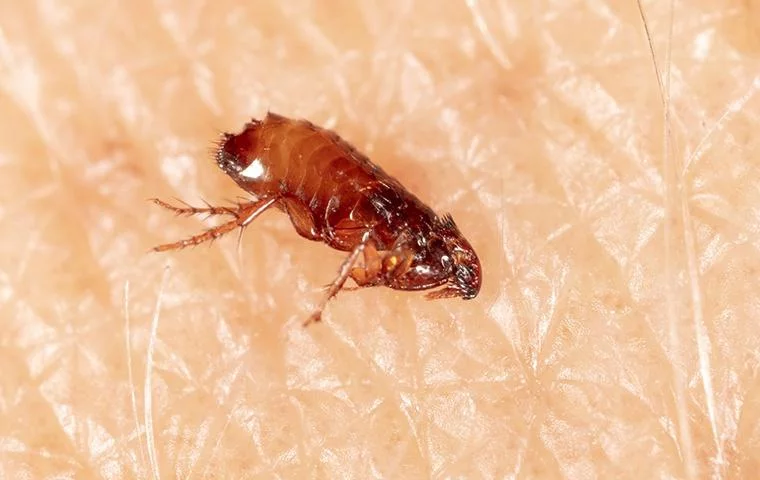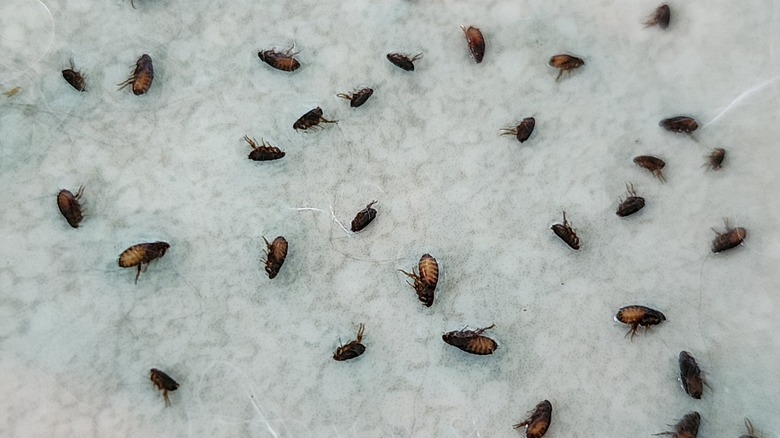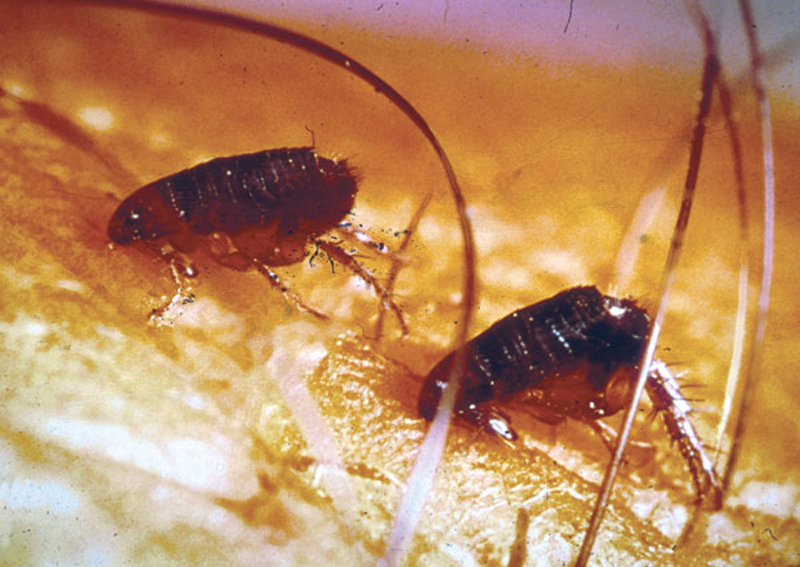Flea Treatments in Florida
Exterminator Services for Clermont, Groveland, Mascotte, Oakland, and Montverde
Florida’s subtropical climate—featuring mild winters, humid summers, and frequent rain—sets the stage for a variety of pests, and fleas rank among the most common. These tiny, hopping insects can be a source of relentless itching for pets and humans if an infestation takes hold in a home or yard. For those in Clermont, as well as nearby communities like Groveland, Mascotte, Oakland, and Montverde, detecting early signs of fleas and pursuing prompt flea treatments is crucial. If overlooked, fleas swiftly multiply, leaving itchy bites, possible diseases, and exasperated occupants. This service page clarifies how fleas flourish in Florida’s environment, signals to watch for around your property, and why partnering with a professional flea exterminator often provides the most thorough solution. By acting promptly, you spare pets from ongoing discomfort, avert repeated occupant bites, and prevent more expansive pest challenges down the line.
Why Fleas Thrive in Florida

- Mild Winter Temperatures
In colder states, severe winter chill slows or kills off many fleas. Florida’s winter, however, usually stays above freezing, giving fleas no extended break from feeding or breeding. Inside heated or air-conditioned homes, fleas find stable warmth year-round—letting even a minor infiltration persist if no occupant intervenes. - High Humidity and Rainfall
Flea eggs and larvae develop best in damp conditions. Florida’s humidity, plus regular rainfall, keeps soils, lawns, and shaded corners moist enough for fleas to mature comfortably. The presence of dew or lightly watered grass fosters microhabitats in which fleas thrive, awaiting a host—like a cat, dog, or passing human. - Minimal Seasonal Dormancy
Fleas in northern climates often face forced dormancy or slowed activity during long, freezing winters. Because Florida rarely hits such extremes, fleas remain capable of breeding continuously, with each generation fueling the next wave if left unchecked. - Frequent Pet Movement and Wildlife
From household cats or dogs roaming local yards to wild animals crossing property lines, Florida’s suburban areas see abundant warm-blooded hosts. Pets without consistent flea preventatives risk picking up fleas at dog parks, while raccoons or feral cats might deposit fleas in yard corners. Once brought indoors, fleas jump onto carpets, pet bedding, or furniture. - Human Mobility
Frequent occupant transitions—like short-term rentals, newly purchased homes, or secondhand furniture acquisitions—enable fleas to hitch rides in clothing seams, used rugs, or shipping boxes. Overlooking a single, egg-bearing flea can spark a full-blown infestation if a suitable environment (damp corners, cozy pet bedding) is found.
Indicators of a Flea Presence
- Pets Scratching Constantly
One of the earliest alarms, a dog or cat repeatedly gnawing at its fur—particularly near the belly, tail, or hind legs—may be dealing with fleas. Some pets develop hair loss or scabs from intense biting if allergic to flea saliva. Using a specialized flea comb can reveal tiny, dark fleas or black “flea dirt” turning red when moistened. - Bites on Humans
Though fleas prefer animal blood, they will bite humans if no other hosts are near. Flea bites commonly appear as red, itchy dots around ankles or lower legs. Clusters of small welts might form lines where fleas hop and bite in quick succession. - Flea Dirt in Pet Bedding
Flea excrement (or “flea dirt”) resembles coarse black pepper. Finding these specks sprinkled across pet blankets, rugs, or near corners of rooms indicates active feeding. If rubbed on damp tissue, flea dirt dissolves into red-brown streaks, confirming digested blood. - Observing Adult Fleas
Adult fleas measure 1–3 millimeters, typically dark brown, with strong hind legs allowing swift jumps. Spotting them on carpets, baseboards, or furniture often occurs when occupant movement disturbs them. If you see multiple fleas inside, an infestation has likely taken root. - Unsettled Pet Behavior
Pets avoiding usual resting spots or acting restless after returning from the yard can signal fleas saturating those areas. Investigating yard corners, shady shrubs, or neglected lawn debris often reveals fleas waiting for a passing animal host.
Why Prompt Flea Treatments Are Necessary
- Potential Disease and Discomfort
While fleas are not the worst disease carriers, some transmit parasites (like tapeworms) that infect pets or, rarely, humans. Extended, heavy flea feeding on a small animal can cause anemia. Eliminating fleas ensures better pet health and occupant well-being. - Rapid Multiplication
Female fleas lay numerous eggs daily, distributing them wherever pets roam—rugs, bedding, or yard grass. Over a few weeks, these eggs mature, perpetuating a cycle of biting and further breeding. A small infiltration swiftly grows if no occupant notices early bites or pet scratching. - Constant Stress
Fleas irritate both pets and owners, imposing endless vacuuming, laundering, or occupant anxiety about potential bites. Thorough eradication alleviates occupant tension, letting them fully enjoy their living spaces again. - Spread to Neighbors
In multi-unit communities or close-knit neighborhoods, fleas can jump across yards or slip through shared hallways if left unchecked. Early occupant action prevents fleas from migrating and setting up multiple zones of infestation.
Why a Professional Exterminator Yields Best Results
- Complete Indoor-Outdoor Survey
A flea exterminator inspects both the inside rooms—carpeted areas, pet bedding, upholstery—and exterior surroundings—fence lines, shady corners, or thick shrubbery. Identifying the species (often cat fleas) and distribution determines the best combination of IGRs, adulticides, or yard solutions. - Targeted and Safe Applications
Over-the-counter foggers risk occupant chemical exposure if misused and do not always penetrate deep corners or yard pockets. Professionals place insect growth regulators or adulticidal sprays in precise trouble spots, ensuring fleas face lethal contact with minimal occupant or pet hazards. - Multi-Stage Life Cycle Approach
Fleas have four stages: egg, larva, pupa, and adult. Missing just one stage—like dormant pupae—lets re-infestations happen. Professionals incorporate insect growth regulators, yard treatments, and occupant-led cleaning to destroy fleas from egg to adult, guaranteeing thorough coverage. - Collaboration with Pet Care
While exterminators address the environment, occupant synergy with veterinarians ensures pets remain on monthly flea preventatives (topicals, oral meds, or collars). If animals remain untreated, fleas jumping onto them outside swiftly reintroduce themselves indoors. - Follow-Up Confirmation
Because eggs might hatch weeks after initial coverage, scheduling re-checks or occupant-based monitoring with sticky traps verifies no newly emerged adults remain. If occupant sightings persist, additional spot treatments finalize extermination, restoring occupant comfort.

Effective Tactics for Flea Control
- Vacuuming and Steam Indoors
Frequent vacuuming across carpets, rugs, pet bedding, or behind furniture sucks up adult fleas, eggs, and debris. Occupants should seal vacuum bags in plastic outside. Steam cleaning can kill fleas deeper in fabrics or cushions where insecticides might fail to penetrate fully. - Insect Growth Regulators (IGRs)
Applying IGR sprays indoors halts larval development, preventing them from transforming into biting adults. Outdoors, larvicides or yard sprays along fence lines, shady corners, or damp yard spots hamper flea populations. Occupants usually wait for dryness before re-entering sprayed zones. - Outdoor Yard Maintenance
Keeping lawns mowed short, trimming shrubs away from walls, and removing leaf litter or yard debris lowers shady, moist pockets fleas use for egg-laying. If possible, limiting visits by stray animals or wildlife also reduces re-introduction. - Pet Routines
Occupants consult veterinarians on monthly flea preventatives. Whether topicals, chewables, or collars, these measures kill fleas feeding on pets, blocking them from reproducing or migrating indoors. Grooming animals frequently and washing their bedding weekly hamper flea survival. - Monitoring
Post-treatment, occupant checks might include sticky traps, combing pets, or scanning floors for adult fleas if occupant movement stirs them. Swift occupant response at the first sign of re-infestation triggers minor spot treatments before fleas can re-establish.
Coverage Areas: Clermont, Groveland, Mascotte, Oakland, Montverde
Clermont: Known for rolling hills and a thriving community. High occupant turnover in new developments or secondhand furniture from yard sales can accidentally introduce fleas indoors. Regular occupant checks, plus routine yard grooming, hamper breeding spots near lakes or wooded edges.
Groveland: Suburban and rural neighborhoods interspersed with farmland. Wildlife crossing yards might deposit eggs or adult fleas into tall grass. Swift occupant diligence—especially if pets roam outdoors—halts fleas from migrating indoors.
Mascotte: A small but growing area seeing new housing expansions, potentially displacing pests from disturbed soil into fresh developments. Quick occupant action upon discovering bites or pet itching ensures small pockets never balloon into extensive home infestations.
Oakland: A scenic region near major routes. If travelers or short-term renters bring fleas on clothing or in suitcases, thorough occupant vacuuming, pet checks, and yard treatments block expansions. Occupant vigilance remains paramount between visitors or occupant transitions.
Montverde: Renowned for scenic spots and partial-year living. Vacant homes or lesser occupant checks could let fleas breed unobserved in quiet rooms. Occasional occupant visits, plus caretaker-based checks, hamper fleas from surprising returning owners or renters.
Why Our Flea Treatments Excel
- Florida-Specific Understanding
Because southwestern Florida rarely sees freezing temperatures, fleas remain active year-round. We integrate occupant measures—such as frequent vacuuming—and targeted insecticides or insect growth regulators, ensuring fleas across all stages face lethal conditions. - Precision and Safety
We concentrate insect growth regulators or adulticidal sprays where fleas lurk: carpets, cracks, or shady yard pockets. By focusing on these hotspots, occupant exposure to chemicals remains low while fleas confront potent coverage that kills them. - Partnership with Pet Health
We emphasize occupant synergy with veterinarian guidance on monthly preventatives or flea shampoos. A secure, pest-free environment indoors plus medicated pets ensures fleas cannot feed or breed effectively, halting re-introduction from outside.
Follow-Up
Because flea eggs and pupae might hatch weeks after initial treatments, scheduling re-checks or occupant-based monitoring (like sticky traps) ensures leftover fleas do not surge anew. If occupant sightings persist, additional targeted steps finalize extermination.

Next Steps
Struggling with pet scratching, noticing small red bites around your ankles, or spotting tiny insects leaping on floors? Contact us to learn more or schedule your service. Our flea exterminator plan in Clermont, Groveland, Mascotte, Oakland, and Montverde addresses each stage of flea life—eggs, larvae, pupae, and adults—both indoors and outdoors, ensuring a comprehensive removal that spares you weeks of biting, itching, and repeated cleaning.
By engaging professional methods—like insect growth regulators, yard larvicides, and occupant-based diligence—fleas lose their foothold. Freed from endless scratching or the frustration of invisible pests lurking in carpets, you can enjoy Florida’s sunshine without constant worry about hidden fleas. Protect pets, reduce occupant stress, and guarantee the comfort of your living or working space by eliminating fleas before they can multiply further.
Sustaining a Flea-Free Environment
After fleas are eliminated, consistent occupant habits keep them at bay:
- Vacuuming: Thoroughly vacuum carpets, rugs, and under furniture weekly, discarding vacuum contents offsite in sealed plastic. This picks up stray fleas or eggs.
- Wash Pet Bedding: Launder pet blankets or crate pads weekly on hot settings, finishing with high-heat drying. Any leftover eggs or larvae perish in strong heat.
- Use Pet Preventatives: Veterinarian-prescribed monthly topicals or chewables ensure that adult fleas cannot survive on pets. Flea collars may also help, but occupant must re-check instructions and switch methods if needed.
- Yard Cleanliness: Short grass, cleared leaf litter, and minimal damp corners hamper flea breeding. If wildlife or stray animals wander in, remove enticing items—like open trash or pet food—that lure them closer to your yard.
- Periodic Checks: Inspect for new bites, fleas on socks if you walk across the yard, or pet itching that recurs. Quick occupant intervention at the first suspicious sign staves off a re-infestation.
By pairing occupant vigilance with robust, professional flea control, southwestern Florida property owners ensure fleas cannot re-establish. Even though Florida’s climate naturally supports ongoing flea activity, integrated environmental management plus medicated pets keep these parasites off your floors and furry companions, letting everyone bask in the region’s pleasant lifestyle without pesky itching or biting.
